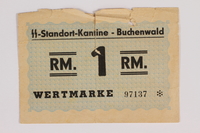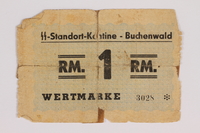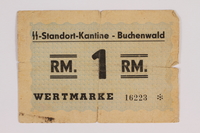Overview
- Brief Narrative
- Concentration camp summer weight uniform jacket worn by 31 year old Symcho (later Simcha) Dymant from December 24, 1944, to April 11, 1945, in Buchenwald concentration camp. When Germany invaded Poland on September 1, 1939, Symcho was living in Czestochowa with his wife Tonia and 3 year old son Aaron. The family was forced into the ghetto after it was established in April 1941. Symcho escaped and, because he spoke German, was able to get a civilian job in a German military installation by assuming the identity of a non-Jewish Polish person. In September 1942, Tonia, Aaron, and the rest of Symcho’s family were sent to Treblinka and killed. The SS discovered that Symcho was Jewish and he was deported to Buchenwald in Germany, arriving on December 24, 1944. He was assigned prisoner number 15349 and was a slave laborer in a nearby military factory. On April 11, 1945, Symcho was liberated by American forces. He lived in Fulda displaced persons camps before joining Kibbutz Buchenwald, started by former camp inmates. A rabbi associated with the group arranged for the Kibbutz members to emigrate to Palestine in September 1945.
- Date
-
use:
1944 December 24-1945 April 11
- Geography
-
issue:
Buchenwald (Concentration camp);
Weimar (Thuringia, Germany)
use: Buchenwald (Concentration camp); Weimar (Thuringia, Germany)
- Credit Line
- United States Holocaust Memorial Museum Collection, Gift of Dr. Jacob Dimant
- Contributor
-
Subject:
Simcha Dimant
- Biography
-
Symcho Dymant was born on February 18, 1913, in Warsaw, Poland, to a Jewish couple, Aharon and Keila Wislicki Dymant. He had three siblings: Alexander, Hindi, and another brother. Aharon, a watchmaker, died in 1915 and Keila died when Symcho was young. He was raised by his grandmother in Sosnowiec. Symcho became a carpenter and settled in Czestochowa. On August 23, 1936, he married Tonia Wargon. They had a son, Aaron, in September 1937.
On September 1, 1939, Germany invaded Poland. They occupied Czestochowa on September 3. Symcho and his family were forcibly moved into the ghetto after it was established on April 9, 1941. Symcho was involved in the underground resistance in the ghetto. Symcho escaped the ghetto. Because he spoke German, he was able to get a civilian job under an assumed identity as a non-Jewish Polish person in a German military installation near the town. In September 1942, the Germans decided to destroy the ghetto. On September 22, Symcho’s mother-in-law was shot in the head by Nazi officials. Symcho’s wife Tonia, 4 year old son Aaron, and all of his relatives were sent to Treblinka killing center. In May 1943, a sympathetic German officer helped Symcho send his sister-in-law, Hela Wargon and her husband Karl, in New York a letter explaining the deportation of the family. The SS discovered that Symcho was Jewish. He was also charged with political crimes and deported to Buchenwald concentration camp in Germany. He arrived on December 24, 1944, and was assigned prisoner number 15349. He was a slave laborer in a nearby military factory. He was active in resistance in the camp. On April 11, 1945, the camp was liberated by American troops.
Just after the war, Symcho worked for the Allied Expeditionary Force, traveling through Germany gathering information on refugees from concentration camp. Symcho moved to Fulda displaced persons camp by the summer. He joined Kibbutz Buchenwald, which was established on a farm by sixteen camp survivors. He met Ita Rozenczwajg (1918-2010). She had survived by living under an assumed identity as a non-Jewish Polish person and was sent to Germany as a Polish forced laborer in 1943. There were two rabbis associated with the group. One went to the British embassy in Paris to get certificates for emigration to Palestine. On September 8, 1945, eighty young men and women from the Kibbutz arrived in Haifa, one of the first large survivor's group to reach Palestine. Symcho changed his name to Simcha Dimant. In 1946, Simcha and Ita married. The couple had two sons. Simcha, age 70, died in 1983.
Physical Details
- Classification
-
Clothing and Dress
- Category
-
Concentration camp uniforms
- Object Type
-
Jackets (lcsh)
- Physical Description
- Blue and white, vertically striped, summer weight cloth jacket, hip-length, with long sleeves and a pointed collar. There is a hook and eye closure at the top of the front opening and some padding on the back of the neck. The front opening has 5 silver-colored metal buttons on the left placket, and 5 roughly cut buttonholes on the right. The plackets are reinforced on the interior with unfaded blue and white, horizontally striped cloth. There is a white, cloth hanging loop on the inside back collar. The hems and seams are machine finished with light brown and light green thread. The cloth is stained and discolored.
- Dimensions
- overall: Height: 23.500 inches (59.69 cm) | Width: 13.875 inches (35.243 cm)
- Materials
- overall : cloth, metal, thread
Rights & Restrictions
- Conditions on Access
- No restrictions on access
- Conditions on Use
- No restrictions on use
Keywords & Subjects
- Topical Term
- Concentration camp inmates--Germany--Biography. Holocaust, Jewish (1939-1945)--Poland--Czestochowa--Personal narratives. Holocaust survivors--Israel--Biography. Jewish refugees--Palestine--Biography. Jews--Persecution--Poland--Czestochowa--Biography. Slave labor--Germany--Biography. World War, 1939-1945--Refugees--Israel--Personal narratives.
Administrative Notes
- Legal Status
- Permanent Collection
- Provenance
- The concentration camp jacket was donated to the United States Holocaust Memorial Museum in 1993 by Dr. Jacob Dimant, the son of Simcha Dimant.
- Funding Note
- The cataloging of this artifact has been supported by a grant from the Conference on Jewish Material Claims Against Germany.
- Record last modified:
- 2022-07-28 18:22:18
- This page:
- https://collections.ushmm.org/search/catalog/irn8178
Download & Licensing
In-Person Research
- By Appointment
- Request 21 Days in Advance of Visit
- Plan a Research Visit
- Request to See This Object
Contact Us
Also in Simcha Dimant collection
The collection consists of Buchenwald concentration camp canteen scrip, a concentration camp uniform jacket, documents, and photographs relating to the experiences of Symcho Dymant before the Holocaust in Czestochowa, Poland, during the Holocaust in Buchenwald concentration camp, and after the Holocaust in Fulda displaced persons camp.
Date: 1936-1945

Buchenwald Standort-Kantine concentration camp scrip, 1 Reichsmark, issued to a Polish Jewish inmate
Object
Buchenwald Kantine scrip received by 31 year old Symcho Dymant while he was an inmate in Buchenwald concentration camp from December 24, 1944, to April 11, 1945. Scrip was issued in the camp as a means of improving worker productivity. This scrip and his jacket in this collection were the only objects he kept with him after the war. When Germany invaded Poland on September 1, 1939, Symcho was living in Czestochowa with his wife Tonia and 3 year old son Aaron. The family was forced to move into the ghetto after it was established in April 1941. Symcho escaped and, because he spoke German, was able to get a civilian job in a German military installation by assuming the identity of a non-Jewish Polish person. In September 1942, Tonia, Aaron, and the rest of Symcho’s family were sent to Treblinka and killed. The SS discovered that Symcho was Jewish and he was deported to Buchenwald in Germany, arriving on December 24, 1944. He was assigned prisoner number 15349 and was a slave laborer in a nearby military factory. On April 11, 1945, Symcho was liberated by American forces. He lived in Fulda displaced persons camps before joining Kibbutz Buchenwald. The rabbi of the kibbutz arranged for the members to emigrate to Palestine in September 1945.

Buchenwald Standort-Kantine concentration camp scrip, 1 Reichsmark, issued to a Polish Jewish inmate
Object
Buchenwald Kantine scrip received by 31 year old Symcho Dymant while an inmate in Buchenwald concentration camp from December 24, 1944, to April 11, 1945. Scrip was issued in the camp as a means of improving worker productivity. This scrip and his jacket in this collection were the only objects he kept with him after the war. When Germany invaded Poland on September 1, 1939, Symcho was living in Czestochowa with his wife Tonia and 3 year old son Aaron. The family was forced into the Jewish ghetto in April 1941. Symcho escaped and, because he spoke German, was able to get a civilian job in a German military installation by assuming the identity of a non-Jewish Polish person. In September 1942, Tonia, Aaron, and the rest of Symcho’s family were sent to Treblinka killing center. The SS discovered that Symcho was Jewish and he was deported to Buchenwald in Germany, arriving on December 24, 1944. He was assigned prisoner number 15349 and was a slave laborer in a nearby military factory. On April 11, 1945, Symcho was liberated by American forces. He lived in Fulda displaced persons camps before joining Kibbutz Buchenwald. The rabbi of the kibbutz arranged for the members to emigrate to Palestine in September 1945.

Buchenwald Standort-Kantine concentration camp scrip, 1 Reichsmark, issued to a Polish Jewish inmate
Object
Buchenwald Kantine scrip received by 31 year old Symcho Dymant while he was an inmate in Buchenwald concentration camp from December 24, 1944, to April 11, 1945. Scrip was issued as a means of improving worker productivity. This scrip and his jacket in this collection were the only objects he kept with him after the war. When Germany invaded Poland on September 1, 1939, Symcho was living in Czestochowa with his wife Tonia and 3 year old son Aaron. The family was forced to move into the ghetto after it was established in April 1941. Symcho escaped and, because he spoke German, was able to get a civilian job in a German military installation by assuming the identity of a non-Jewish Polish person. In September 1942, Tonia, Aaron, and the rest of Symcho’s family were sent to Treblinka and killed. The SS discovered that Symcho was Jewish and he was deported to Buchenwald in Germany, arriving on December 24, 1944. He was assigned prisoner number 15349 and was a slave laborer in a nearby military factory. On April 11, 1945, Symcho was liberated by American forces. He lived in Fulda displaced persons camps before joining Kibbutz Buchenwald. The rabbi of the kibbutz arranged for the members to emigrate to Palestine in September 1945.



